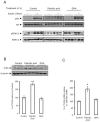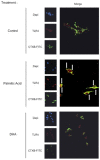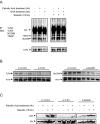Palmitic acid promotes resistin-induced insulin resistance and inflammation in SH-SY5Y human neuroblastoma
- PMID: 33686181
- PMCID: PMC7940652
- DOI: 10.1038/s41598-021-85018-7
Palmitic acid promotes resistin-induced insulin resistance and inflammation in SH-SY5Y human neuroblastoma
Erratum in
-
Publisher Correction: Palmitic acid promotes resistin‑induced insulin resistance and inflammation in SH‑SY5Y human neuroblastoma.Sci Rep. 2021 Jun 15;11(1):12935. doi: 10.1038/s41598-021-92151-w. Sci Rep. 2021. PMID: 34131233 Free PMC article. No abstract available.
Abstract
Saturated fatty acids such as palmitic acid promote inflammation and insulin resistance in peripheral tissues, contrasting with the protective action of polyunsaturated fatty acids such docosahexaenoic acid. Palmitic acid effects have been in part attributed to its potential action through Toll-like receptor 4. Beside, resistin, an adipokine, also promotes inflammation and insulin resistance via TLR4. In the brain, palmitic acid and resistin trigger neuroinflammation and insulin resistance, but their link at the neuronal level is unknown. Using human SH-SY5Yneuroblastoma cell line we show that palmitic acid treatment impaired insulin-dependent Akt and Erk phosphorylation whereas DHA preserved insulin action. Palmitic acid up-regulated TLR4 as well as pro-inflammatory cytokines IL6 and TNFα contrasting with DHA effect. Similarly to palmitic acid, resistin treatment induced the up-regulation of IL6 and TNFα as well as NFκB activation. Importantly, palmitic acid potentiated the resistin-dependent NFkB activation whereas DHA abolished it. The recruitment of TLR4 to membrane lipid rafts was increased by palmitic acid treatment; this is concomitant with the augmentation of resistin-induced TLR4/MYD88/TIRAP complex formation mandatory for TLR4 signaling. In conclusion, palmitic acid increased TLR4 expression promoting resistin signaling through TLR4 up-regulation and its recruitment to membrane lipid rafts.
Conflict of interest statement
The authors declare no competing interests.
Figures







Similar articles
-
Resistin inhibits neuronal autophagy through Toll-like receptor 4.J Endocrinol. 2018 Jul;238(1):77-89. doi: 10.1530/JOE-18-0096. Epub 2018 May 17. J Endocrinol. 2018. PMID: 29773580
-
Maternal resistin predisposes offspring to hypothalamic inflammation and body weight gain.PLoS One. 2019 Mar 7;14(3):e0213267. doi: 10.1371/journal.pone.0213267. eCollection 2019. PLoS One. 2019. PMID: 30845245 Free PMC article.
-
Reciprocal modulation of Toll-like receptor-4 signaling pathways involving MyD88 and phosphatidylinositol 3-kinase/AKT by saturated and polyunsaturated fatty acids.J Biol Chem. 2003 Sep 26;278(39):37041-51. doi: 10.1074/jbc.M305213200. Epub 2003 Jul 15. J Biol Chem. 2003. PMID: 12865424
-
Mechanisms for the activation of Toll-like receptor 2/4 by saturated fatty acids and inhibition by docosahexaenoic acid.Eur J Pharmacol. 2016 Aug 15;785:24-35. doi: 10.1016/j.ejphar.2016.04.024. Epub 2016 Apr 13. Eur J Pharmacol. 2016. PMID: 27085899 Free PMC article. Review.
-
Resistin and visfatin: regulators of insulin sensitivity, inflammation and immunity.Endocr Regul. 2010 Jan;44(1):25-36. doi: 10.4149/endo_2010_01_25. Endocr Regul. 2010. PMID: 20151765 Review.
Cited by
-
Protection Strategies Against Palmitic Acid-Induced Lipotoxicity in Metabolic Syndrome and Related Diseases.Int J Mol Sci. 2025 Jan 18;26(2):788. doi: 10.3390/ijms26020788. Int J Mol Sci. 2025. PMID: 39859502 Free PMC article. Review.
-
Investigation of Microplastics (≥10 μm) in Meconium by Fourier Transform Infrared Microspectroscopy.Toxics. 2023 Mar 27;11(4):310. doi: 10.3390/toxics11040310. Toxics. 2023. PMID: 37112537 Free PMC article.
-
Glycerophospholipid Analysis of Optic Nerve Regeneration Models Indicate Potential Membrane Order Changes Associated with the Lipidomic Shifts.J Ocul Pharmacol Ther. 2023 Oct;39(8):519-529. doi: 10.1089/jop.2023.0003. Epub 2023 May 16. J Ocul Pharmacol Ther. 2023. PMID: 37192491 Free PMC article.
-
Red Oranges and Olive Leaf Waste-Derived Bioactive Extracts Promote Adipocyte Functionality In Vitro.Nutrients. 2024 Jun 19;16(12):1959. doi: 10.3390/nu16121959. Nutrients. 2024. PMID: 38931313 Free PMC article.
-
Preferential deposition of dairy derived fatty acids in muscle tissue is partially due to the upregulation of CD36 in a low-birth-weight swine model.J Anim Sci. 2023 Jan 3;101:skad113. doi: 10.1093/jas/skad113. J Anim Sci. 2023. PMID: 37086180 Free PMC article.
References
-
- Ilievski V, Cho Y, Katwala P, Rodriguez H, Tulowiecka M, Kurian D, Leoni L, Christman JW, Unterman TG, Watanabe K. TLR4 expression by liver resident cells mediates the development of glucose intolerance and insulin resistance in experimental periodontitis. PLoS ONE. 2015;10(8):e0136502. doi: 10.1371/journal.pone.0136502. - DOI - PMC - PubMed
-
- Zheng C, Yang Q, Xu C, Shou P, Cao J, Jiang M, Chen Q, Cao G, Han Y, Li F, Cao W, Zhang L, Shi Y, Wang Y. CD11b regulates obesity-induced insulin resistance via limiting activation and proliferation of adipose tissue macrophages. Proc. Natl. Acad. Sci. USA. 2015;112:E7239–E7248. doi: 10.1073/pnas.1500396113. - DOI - PMC - PubMed
-
- Kain V, Kapadia B, Viswakarma N, Seshadri S, Prajapati B, Jena PK, Meda CLT, Subramanian M, Suraj SK, Kumar ST, Babu PP, Thimmapaya B, Reddy JK, Parsa KVL, Misra P. Co-activator binding protein PIMT mediates TNFa induced insulin resistance in skeletal muscle via the transcriptional down-regulation of MEF2A and Glut4. Sci. Rep. 2015;5:15197. doi: 10.1038/srep15197. - DOI - PMC - PubMed
Publication types
MeSH terms
Substances
LinkOut - more resources
Full Text Sources
Other Literature Sources
Medical
Miscellaneous

